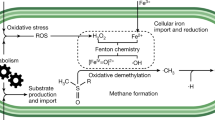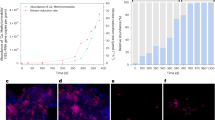Abstract
Methane (CH4) is a potent greenhouse gas that is released from fossil fuels and is also produced by microbial activity, with at least one billion tonnes of CH4 being formed and consumed by microorganisms in a single year1. Complex methanogenesis pathways used by archaea are the main route for bioconversion of carbon dioxide (CO2) to CH4 in nature2,3,4. Here, we report that wild-type iron-iron (Fe-only) nitrogenase from the bacterium Rhodopseudomonas palustris reduces CO2 simultaneously with nitrogen gas (N2) and protons to yield CH4, ammonia (NH3) and hydrogen gas (H2) in a single enzymatic step. The amount of CH4 produced by purified Fe-only nitrogenase was low compared to its other products, but CH4 production by this enzyme in R. palustris was sufficient to support the growth of an obligate CH4-utilizing Methylomonas strain when the two microorganisms were grown in co-culture, with oxygen (O2) added at intervals. Other nitrogen-fixing bacteria that we tested also formed CH4 when expressing Fe-only nitrogenase, suggesting that this is a general property of this enzyme. The genomes of 9% of diverse nitrogen-fixing microorganisms from a range of environments encode Fe-only nitrogenase. Our data suggest that active Fe-only nitrogenase, present in diverse microorganisms, contributes CH4 that could shape microbial community interactions.
This is a preview of subscription content, access via your institution
Access options
Access Nature and 54 other Nature Portfolio journals
Get Nature+, our best-value online-access subscription
$29.99 / 30 days
cancel any time
Subscribe to this journal
Receive 12 digital issues and online access to articles
$119.00 per year
only $9.92 per issue
Buy this article
- Purchase on Springer Link
- Instant access to full article PDF
Prices may be subject to local taxes which are calculated during checkout




Similar content being viewed by others
References
Thauer, R. K. & Shima, S. Biogeochemistry: methane and microbes. Nature 440, 878–879 (2006).
Yvon-Durocher, G. et al. Methane fluxes show consistent temperature dependence across microbial to ecosystem scales. Nature 507, 488–491 (2014).
Thauer, R. K., Kaster, A. K., Seedorf, H., Buckel, W. & Hedderich, R. Methanogenic archaea: ecologically relevant differences in energy conservation. Nat. Rev. Microbiol. 6, 579–591 (2008).
Brauer, S. L., Cadillo-Quiroz, H., Yashiro, E., Yavitt, J. B. & Zinder, S. H. Isolation of a novel acidiphilic methanogen from an acidic peat bog. Nature 442, 192–194 (2006).
Ferry, J. G. Fundamentals of methanogenic pathways that are key to the biomethanation of complex biomass. Curr. Opin. Biotech. 22, 351–357 (2011).
Metcalf, W. W. et al. Synthesis of methylphosphonic acid by marine microbes: a source for methane in the aerobic ocean. Science 337, 1104–1107 (2012).
Schauder, R., Eikmanns, B., Thauer, R. K., Widdel, F. & Fuchs, G. Acetate oxidation to CO2 in anaerobic bacteria via a novel pathway not involving reactions of the citric acid cycle. Arch. Microbiol. 145, 162–172 (1986).
Vorholt, J., Kunow, J., Stetter, K. O. & Thauer, R. K. Enzymes and coenzymes of the carbon monoxide dehydrogenase pathway for autotrophic CO2 fixation in Archaeoglobus lithotrophicus and the lack of carbon monoxide dehydrogenase in the heterotrophic A. profundus. Arch. Microbiol. 163, 112–118 (1995).
Spatzal, T. The center of biological nitrogen fixation: FeMo-cofactor. Z. Anorg. Allg. Chem. 641, 10–17 (2015).
Eady, R. R. Structure-function relationships of alternative nitrogenases. Chem. Rev. 96, 3013–3030 (1996).
Bishop, P. E. & Joerger, R. D. Genetics and molecular biology of alternative nitrogen fixation systems. Annu. Rev. Plant Phys. 41, 109–125 (1990).
Helz, G. R. et al. Mechanism of molybdenum removal from the sea and its concentration in black shales: EXAFS evidence. Geochim. Cosmochim. Acta 60, 3631–3642 (1996).
Barron, A. R. et al. Molybdenum limitation of asymbiotic nitrogen fixation in tropical forest soils. Nat. Geosci. 2, 42–45 (2009).
Zhang, X. et al. Alternative nitrogenase activity in the environment and nitrogen cycle implications. Biogeochemistry 127, 189–198 (2016).
McRose, D. L., Zhang, X., Kraepiel, A. M. & Morel, F. M. Diversity and activity of alternative nitrogenases in sequenced genomes and coastal environments. Front. Microbiol. 8, 267 (2017).
Seefeldt, L. C., Yang, Z.-Y., Duval, S. & Dean, D. R. Nitrogenase reduction of carbon-containing compounds. Biochim. Biophys. Acta 1827, 1102–1111 (2013).
Lee, C. C. et al. Uncoupling binding of substrate CO from turnover by vanadium nitrogenase. Proc. Natl Acad. Sci. USA 112, 13845–13849 (2015).
Lee, C. C., Hu, Y. & Ribbe, M. W. Vanadium nitrogenase reduces CO. Science 329, 642 (2010).
Hu, Y., Lee, C. C. & Ribbe, M. W. Extending the carbon chain: hydrocarbon formation catalyzed by vanadium/molybdenum nitrogenases. Science 333, 753–755 (2011).
Yang, Z.-Y., Dean, D. R. & Seefeldt, L. C. Molybdenum nitrogenase catalyzes the reduction and coupling of CO to form hydrocarbons. J. Biol. Chem. 286, 19417–19421 (2011).
Yang, Z.-Y., Moure, V. R., Dean, D. R. & Seefeldt, L. C. Carbon dioxide reduction to methane and coupling with acetylene to form propylene catalyzed by remodeled nitrogenase. Proc. Natl Acad. Sci. USA 109, 19644–19648 (2012).
Hoffman, B. M., Lukoyanov, D., Yang, Z.-Y., Dean, D. R. & Seefeldt, L. C. Mechanism of nitrogen fixation by nitrogenase: the next stage. Chem. Rev. 114, 4041–4062 (2014).
Fixen, K. R. et al. Light-driven carbon dioxide reduction to methane by nitrogenase in a photosynthetic bacterium. Proc. Natl Acad. Sci. USA 113, 10163–10167 (2016).
Oda, Y. et al. Functional genomic analysis of three nitrogenase isozymes in the photosynthetic bacterium Rhodopseudomonas palustris. J. Bacteriol. 187, 7784–7794 (2005).
McKinlay, J. B. & Harwood, C. S. Carbon dioxide fixation as a central redox cofactor recycling mechanism in bacteria. Proc. Natl Acad. Sci. USA 107, 11669–11675 (2010).
Masepohl, B. & Hallenbeck, P. C. Nitrogen and molybdenum control of nitrogen fixation in the phototrophic bacterium Rhodobacter capsulatus. Adv. Exp. Med. Biol. 675, 49–70 (2010).
Waugh, S. I. et al. The genes encoding the delta subunits of dinitrogenases 2 and 3 are required for Mo-independent diazotrophic growth by Azotobacter vinelandii. J. Bacteriol. 177, 1505–1510 (1995).
Lehman, L. J. & Roberts, G. P. Identification of an alternative nitrogenase system in Rhodospirillum rubrum. J. Bacteriol. 173, 5705–5711 (1991).
Stanley, E. H. et al. The ecology of methane in streams and rivers: patterns, controls, and global significance. Ecol. Monogr. 86, 146–171 (2016).
Auman, A. J., Stolyar, S., Costello, A. M. & Lidstrom, M. E. Molecular characterization of methanotrophic isolates from freshwater lake sediment. Appl. Environ. Microbiol. 66, 5259–5266 (2000).
Kim, M. K. & Harwood, C. S. Regulation of benzoate-CoA ligase in Rhodopseudomonas palustris. FEMS Microbiol. Lett. 83, 199–203 (1991).
Huang, J. J., Heiniger, E. K., McKinlay, J. B. & Harwood, C. S. Production of hydrogen gas from light and the inorganic electron donor thiosulfate by Rhodopseudomonas palustris. Appl. Environ. Microbiol. 76, 7717–7722 (2010).
Toukdarian, A. & Kennedy, C. Regulation of nitrogen metabolism in Azotobacter vinelandii: isolation of ntr and glnA genes and construction of ntr mutants. EMBO J. 5, 399–407 (1986).
Rey, F. E., Heiniger, E. K. & Harwood, C. S. Redirection of metabolism for biological hydrogen production. Appl. Environ. Microbiol. 73, 1665–1671 (2007).
Robinson, A. C., Burgess, B. K. & Dean, D. R. Activity, reconstitution, and accumulation of nitrogenase components in Azotobacter vinelandii mutant strains containing defined deletions within the nitrogenase structural gene cluster. J. Bacteriol. 166, 180–186 (1986).
Bishop, P. E., Jarlenski, D. M. L. & Hetherington, D. R. Evidence for an alternative nitrogen fixation system in Azotobacter vinelandii. Proc. Natl Acad. Sci. USA 77, 7342–7346 (1980).
Premakumar, R., Jacobitz, S., Ricke, S. C. & Bishop, P. E. Phenotypic characterization of a tungsten-tolerant mutant of Azotobacter vinelandii. J. Bacteriol. 178, 691–696 (1996).
Christiansen, J., Goodwin, P. J., Lanzilotta, W. N., Seefeldt, L. C. & Dean, D. R. Catalytic and biophysical properties of a nitrogenase apo-MoFe protein produced by a nifB-deletion mutant of Azotobacter vinelandii. Biochemistry 37, 12611–12623 (1998).
Peters, J. W., Fisher, K. & Dean, D. R. Identification of a nitrogenase protein-protein interaction site defined by residues 59 through 67 within the Azotobacter vinelandii Fe protein. J. Biol. Chem. 269, 28076–28083 (1994).
Corbin, J. L. Liquid chromatographic-fluorescence determination of ammonia from nitrogenase reactions: a 2-min assay. Appl. Environ. Microbiol. 47, 1027–1030 (1984).
Barney, B. M., Igarashi, R. Y., Dos Santos, P. C., Dean, D. R. & Seefeldt, L. C. Substrate interaction at an iron-sulfur face of the FeMo-cofactor during nitrogenase catalysis. J. Biol. Chem. 279, 53621–53624 (2004).
Whittenbury, R., Phillips, K. C. & Wilkinson, J. F. Enrichment, isolation and some properties of methane-utilizing bacteria. J. Gen. Microbiol. 61, 205–218 (1970).
Yu, Z., Krause, S. M. B., Beck, D. A. C. & Chistoserdova, L. A synthetic ecology perspective: how well does behavior of model organisms in the laboratory predict microbial activities in natural habitats? Front. Microbiol. 7, 946 (2016).
Fu, Y., Beck, D. A. C. & Lidstrom, M. E. Difference in C3-C4 metabolism underlies tradeoff between growth rate and biomass yield in Methylobacterium extorquens AM1. BMC Microbiol. 16, 156 (2016).
Acknowledgements
We thank the entire Biological Electron Transfer and Catalysis (BETCy) team for informative discussions. We also thank G. Roberts, Y. Zhang, J. McKinlay and F. Daldal for the generous gifts of R. rubrum and R. capsulatus strains, S. Shaw for assistance with activity assays and M. Tokmina-Lukaszewska for the verification of purified Fe-only nitrogenase by mass spectrometry. This work was supported as part of the BETCy Energy Frontier Research Center (EFRC), an EFRC funded by the US Department of Energy, Office of Science Grant DE-SC0012518.
Author information
Authors and Affiliations
Contributions
Y.Z., D.F.H., Z.Y, K.R.F., E.S.B., M.E.L., L.C.S. and C.S.H. designed the research. Y.Z. performed the in vivo studies of photosynthetic bacteria. Y.Z. and K.R.F. made the R. palustris mutants. Y.Z. grew the R. palustris cells. D.F.H. purified the Fe-only nitrogenase and did the enzyme assays. Z.Y. and Y.F. performed the co-culture experiments. Y.F. carried out the analysis of 13C-labeled metabolites. S.P. completed the taxonomic distribution of nitrogenases; R.N.L. performed the CH4 measurement of A. vinelandii. Z.-Y.Y. performed the GC–MS analysis of CH4. Y.Z., D.F.H., K.R.F., E.S.B., M.E.L., L.C.S. and C.S.H. analysed the data. Y.Z., E.S.B., M.E.L., L.C.S. and C.S.H. wrote the paper. All authors contributed to the revision of the manuscript.
Corresponding author
Ethics declarations
Competing interests
The authors declare no competing financial interests.
Additional information
Publisher’s note: Springer Nature remains neutral with regard to jurisdictional claims in published maps and institutional affiliations.
Supplementary information
Supplementary Information
Supplementary Figures 1–4, Supplementary Tables 1 and 2.
Rights and permissions
About this article
Cite this article
Zheng, Y., Harris, D.F., Yu, Z. et al. A pathway for biological methane production using bacterial iron-only nitrogenase. Nat Microbiol 3, 281–286 (2018). https://doi.org/10.1038/s41564-017-0091-5
Received:
Accepted:
Published:
Issue Date:
DOI: https://doi.org/10.1038/s41564-017-0091-5
This article is cited by
-
Full quantitative resource utilization of raw mustard waste through integrating a comprehensive approach for producing hydrogen and soil amendments
Microbial Cell Factories (2024)
-
Structural insights into the iron nitrogenase complex
Nature Structural & Molecular Biology (2024)
-
Rice N-biofertilization by inoculation with an engineered photosynthetic diazotroph
World Journal of Microbiology and Biotechnology (2024)
-
Methylphosphonate-driven methane formation and its link to primary production in the oligotrophic North Atlantic
Nature Communications (2023)
-
Iron-only Fe-nitrogenase underscores common catalytic principles in biological nitrogen fixation
Nature Catalysis (2023)



